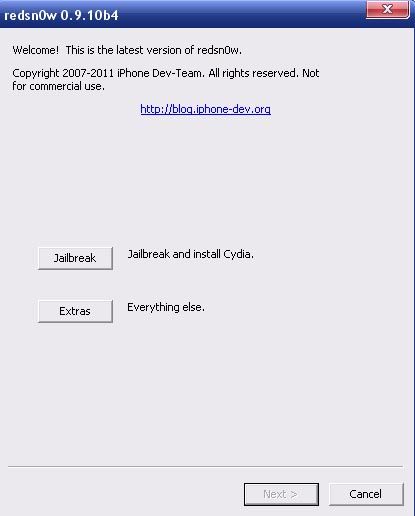
- #Redsn0w 7.1.2 mac os#
- #Redsn0w 7.1.2 install#
- #Redsn0w 7.1.2 serial#
- #Redsn0w 7.1.2 Patch#
- #Redsn0w 7.1.2 software#
You can directly download these files and skip all the above steps. Note: I have created the patched kernel and a custom Ramdisk for iPhone 4. All of the steps listed above create a patched kernel and a custom Ramdisk with forensic tools. The Ramdisk image is just a plain HFS+ file system (native to Macs, making it fairly simple to add files to it). Running the shell script downloads, the forensic tool kit adds it to the Ramdisk. The above python script creates a patched kernel and a shell script to create Ramdisk.
#Redsn0w 7.1.2 Patch#
To patch the signature checks in kernel, supply iOS 5 ipsw file to kernel_patcher.py
#Redsn0w 7.1.2 install#
In order to run the tools, we first need to install all the dependencies (use the commands listed below from OS X terminal).ĭownload ldid, grant execute permissions and move it to /usr/bin directory.ĭownload & install python modules – pycrypto, M2crypto, construct and progressbar.ĭownload and install Mercurial () to check out the source code from the repository.ĭownload redsn0w to fetch encryption keys to decrypt Ramdisk and Kernel. The entire forensic toolkit contains python scripts, a few binaries and a few shell scripts.
#Redsn0w 7.1.2 mac os#
With the open forensic toolkit released by Sogeti Labs, we can build Ramdisk only on MAC OS X. Later, we will use jailbreak tools to load our kernel by patching BootRom signature checks. These encryption keys can be grabbed from JailBreaking tools.įirst, we will build a custom ram disk using all of our forensic tools and patch the ram disk signature checks in kernel. Apart from signature checks, every stage is also encrypted. By using these, we can flash our own boot loader and patch all other signature checks in all the subsequent stages.


The hacker community has found several vulnerabilities in BootRom. In the chain of trust boot sequence, if we compromise one link, we can fully control all the links that follow. To load our custom Ramdisk, we have to bypass all these signature checks. Signature checks implemented at various stages in the boot sequence do not allow us to load our custom Ramdisk. In Forensics, we will create a custom Ramdisk with our complete forensic tool kit and load it into the iPhone’s volatile memory. Boot loader signature checks the kernel, and the kernel signature checks the Ramdisk.ĭuring iOS update, the Ramdisk gets loaded into RAM and it loads all the other OS components. BootRom signature checks the second level boot loaders (iBSS, iBEC). In DFU mode, iPhone follows the boot sequence with a series of signature checks as shown below. iBoot signature checks the kernel and device tree, while the kernel signature checks all the user applications. LLB signature checks and loads the stage 2 boot loader (iBoot). In Normal mode, BootRom start off some initialization stuff and loads the low level boot loader (LLB) by verifying its signature. IPhone operates in 3 modes – Normal Mode, Recovery Mode, DFU mode BootRom contains all the root certificates to signature check the next stage. The BootRom is Read-only memory (ROM) and it is the first stage of booting an iOS device.
#Redsn0w 7.1.2 software#
When an iPhone boots up, it walks through a chain of trust, which is a series of RSA signature checks among the software components in a specific order as shown below: ipsw extension) that contains boot loaders, kernel, system software, shared libraries & built in applications. iOS (previously known as iPhone OS) is the operating system that runs on all Apple devices like iPhone, iPod, Apple TV and iPad. In order to create and load the forensic toolkit, first we need to understand iPhone functions at the operating system level. The problem here is: the iPhone only loads firmware designed by Apple.
#Redsn0w 7.1.2 serial#
As the iPhone has only one serial port, we are going to load custom OS over the USB to access the hard disk of the device. To perform iPhone forensics, we use the Live CD approach. So it is not easy to take out the chips (hard disk) and dump data into it. When we compare computers to the iPhone, it is an embedded device. Imagine a computer which is protected with an OS level password – we can still access the hard disk data by booting a live CD, or by removing the hard disk and connecting it to another machine. Creating & Loading the forensic toolkit.Bypassing the iPhone passcode restrictions.Establishing a communication between the device and the computer.Creating & Loading a forensic toolkit on to the device without damaging the evidence.Steps involved in iPhone forensics include:

The details shown below outline their research and give an overview on the usage of iPhone forensic tools. Researchers at Sogeti Labs have released open source forensic tools (with the support of iOS 5) to recover low level data from the iPhone. GOAL Extracting data and artifacts from iPhone without altering the information on the device

IPhone 4 GSM model with iOS 5 is used for forensics.


 0 kommentar(er)
0 kommentar(er)
